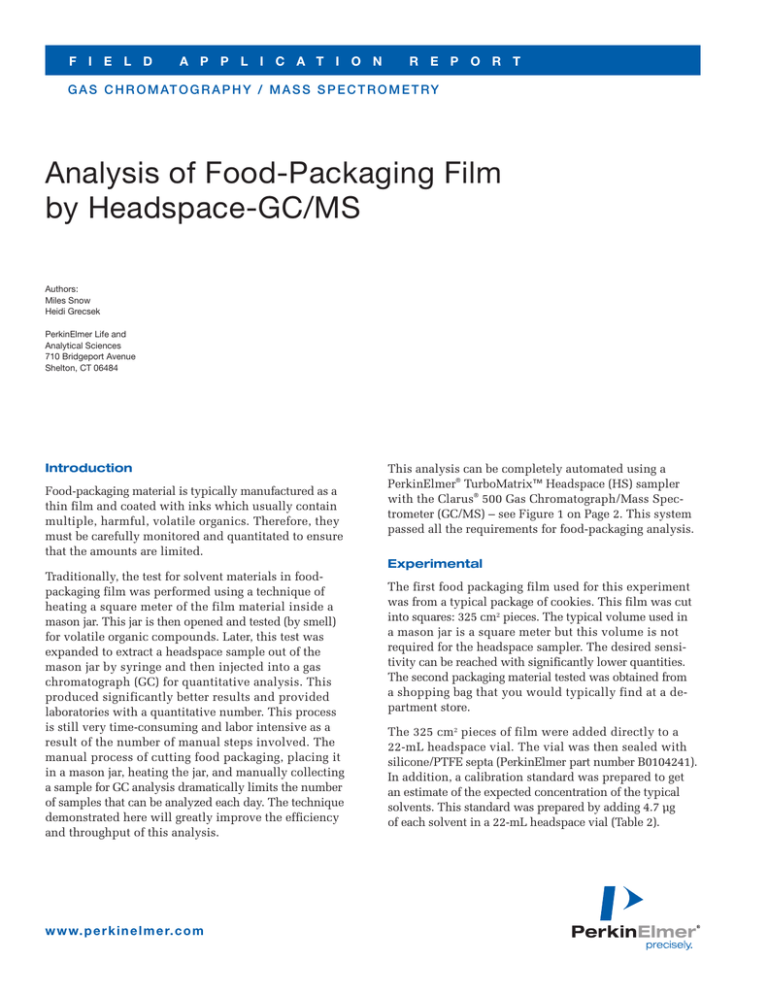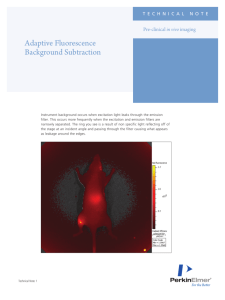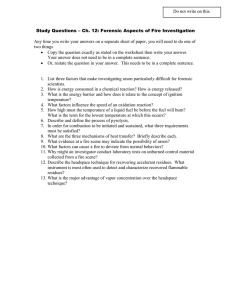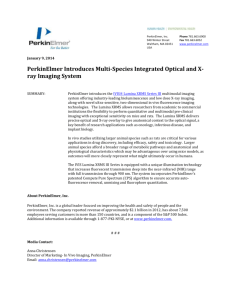
F I E L D
A P P L I C A T I O N
R E P O R T
G A S C H R O M AT O G R A P H Y / M A S S S P E C T R O M E T R Y
Analysis of Food-Packaging Film
by Headspace-GC/MS
Authors:
Miles Snow
Heidi Grecsek
PerkinElmer Life and
Analytical Sciences
710 Bridgeport Avenue
Shelton, CT 06484
Introduction
Food-packaging material is typically manufactured as a
thin film and coated with inks which usually contain
multiple, harmful, volatile organics. Therefore, they
must be carefully monitored and quantitated to ensure
that the amounts are limited.
This analysis can be completely automated using a
PerkinElmer® TurboMatrix™ Headspace (HS) sampler
with the Clarus® 500 Gas Chromatograph/Mass Spectrometer (GC/MS) – see Figure 1 on Page 2. This system
passed all the requirements for food-packaging analysis.
Experimental
Traditionally, the test for solvent materials in foodpackaging film was performed using a technique of
heating a square meter of the film material inside a
mason jar. This jar is then opened and tested (by smell)
for volatile organic compounds. Later, this test was
expanded to extract a headspace sample out of the
mason jar by syringe and then injected into a gas
chromatograph (GC) for quantitative analysis. This
produced significantly better results and provided
laboratories with a quantitative number. This process
is still very time-consuming and labor intensive as a
result of the number of manual steps involved. The
manual process of cutting food packaging, placing it
in a mason jar, heating the jar, and manually collecting
a sample for GC analysis dramatically limits the number
of samples that can be analyzed each day. The technique
demonstrated here will greatly improve the efficiency
and throughput of this analysis.
w w w. p e r k i n e l m e r. c o m
The first food packaging film used for this experiment
was from a typical package of cookies. This film was cut
into squares: 325 cm2 pieces. The typical volume used in
a mason jar is a square meter but this volume is not
required for the headspace sampler. The desired sensitivity can be reached with significantly lower quantities.
The second packaging material tested was obtained from
a shopping bag that you would typically find at a department store.
The 325 cm2 pieces of film were added directly to a
22-mL headspace vial. The vial was then sealed with
silicone/PTFE septa (PerkinElmer part number B0104241).
In addition, a calibration standard was prepared to get
an estimate of the expected concentration of the typical
solvents. This standard was prepared by adding 4.7 µg
of each solvent in a 22-mL headspace vial (Table 2).
The instrument used for this analysis was a TurboMatrix
HS 40 Headspace Trap sampler run in headspace-only
mode. This bypassed the trapping capability. If extra
sensitivity is required, the trap option could be used for
up to 100 times lower detection levels. The shaker option
on the headspace was utilized for a faster equilibration
of the solid film material. The headspace was controlled
using the TurboMatrix remote control software and was
coupled to the Clarus 500 GC/MS. The Clarus 500 GC
was equipped with a programmable split/splitless (PSS)
injector and programmable pneumatic control (PPC).
Deactivated fused silica (0.32 mm) transfer line connects the TurboMatrix HS 40 Trap to the Clarus GC.
The GC column was directly connected to this transfer
line using a universal union (PerkinElmer part number
N9302149). The Clarus 500 MS was controlled via
TurboMass™ 5.1 GC/MS software and operated in
electron ionization (EI) mode.
Results
The TurboMatrix HS 40 Headspace sampler was successful
in analyzing the solvents in food packaging. Six solvents
were identified: 1 – MIBK (Methyl Isobutyl Ketone), 2 –
NPAC (n-Propyl Acetate), 3 – ETAC (Ethyl Acetate), 4 –
Propanol, 5 – ETOH (Ethanol) and 6 – Heptane (Figures
2 and 3). Ethanol and Propanol were the largest responders
and overloaded the system. However, the requirements
of the testing were to only get semi-quantitative information. Therefore, the overloading was accepted. All
components were positively identified using a NIST
library database.
Figure 1. Clarus 500 GC/MS with TurboMatrix Headspace Trap.
2
The cookie package/wrapper had approximately
0.22 mg/m2 of solvents found. However, Propanol was
very significant, making up the large majority of the total
solvents identified. The cookie wrapper also had a lower
level of interferences from outside sources (Figure 2).
The shopping bag (purple) had approximately 0.32 mg/m2
of total solvent material (of the six solvents tested) –
Table 2. This represented a very good response of all six
solvents. In addition, there is a significant amount of
other materials found in the food film. This is evident
in the chromatogram shown on Figure 3. Because of
the ability of the MS to extract only the required ion
from the component of interest, this interference was
not an issue.
The headspace system enabled the method to be set up
and run unattended with no sample preparation. This
eliminated the need for mason jars and operator attention. In addition, the system showed a significant
amount of sensitivity for the required components, demonstrating the ease of setup methodologies of many
types of food packaging at many different levels.
The significant response of the volatile solvent material
by this heated headspace technique would allow for a
flame ionization detector (FID) to be used as a substitute
for the MS detector. While the MS gives a positive
identification as well as selectivity, the FID can be used
in a majority of standard QA/QC environments.
Figure 2. Chromatogram of cookie wrapper.
Figure 3. Chromatogram of shopping-bag film – with expanded ethanol
chromatogram.
Table 1. Instrument Parameters.
GC
Injector Temp:
Headspace Trap
120 ˚C
Needle Temp:
85 ˚C
Oven Program – Initial Temp:
35 ˚C
Transfer-Line Temp:
85 ˚C
Initial Time:
Hold 2 mins
Oven Temp:
80 ˚C
Ramp:
10 ˚C/min
Shaker:
On
Final Temp:
200 ˚C
High-Pressure Injection:
On
Final Time:
Hold 5 mins
Trap Option:
Off
Column:
Elite 200*
Constant Mode:
On
MS
SIFI Conditions EI
Thermostatting Time:
30 min
Mass Range:
30-300 amu
Pressurization Time:
1 min
Scan Time:
0.41 sec
Withdrawal Time:
1 min
InterScan Delay:
0.01 sec
Injection Pressure:
20 psi
Transfer-Line Temp:
200 ˚C
Column Pressure:
25 psi
Electron Energy:
70 eV
Injection Time:
0.08 min
Detector Voltage:
400 V
GC Cycle Time:
35 min
Threshold:
0
Carrier Gas:
Helium at 99.999%
*PerkinElmer part number – N9316630 (30 m, 0.32 mm, 1µ).
w w w. p e r k i n e l m e r. c o m
3
Conclusions
sample is placed into a vial and placed in the autosampler
tray of the headspace. Then the automated analysis is
completed without operator attention. In addition, the
headspace’s overlapping thermostatting allows up to 12
samples to be processed simultaneously, thus allowing
50-75 analyses per day.
The PerkinElmer TurboMatrix Headspace Trap with the
Clarus 500 GC/MS meets all the requirements for foodpackaging analysis. The main requirement for this
application is fast, easy and quantitative solvent
determination. Using the setup demonstrated here, the
Table 2. Semi-Quantitative Results.
Sample: Standard
Peak #
Solvent Name
RT (min)
Area
µg in Vial
1
MIBK
5.104
15165890
4.7
2
NPAC
4.663
19381950
4.7
3
ETAC
2.932
14047220
4.7
4
Propanol
2.256
16693610
4.7
5
ETOH
1.518
31902978
4.7
6
Heptane
4.69
12375010
4.7
Area
µg in Vial
2
Sample: Purple Shopping Bag 300 cm
Peak #
Solvent Name
RT (min)
mg/m2
1
MIBK
5.12
162823
0.05
0.00
2
NPAC
4.665
4010297
0.97
0.03
3
ETAC
2.927
4236236
1.42
0.04
4
Propanol
2.244
19894030
5.6
0.17
5
ETOH
1.526
15599010
2.3
0.07
6
Heptane
4.686
14941
0.01
0.00
Total
0.32
Sample: Cookie Wrapper 325 cm2
Peak #
Solvent Name
RT (min)
Area
µg in Vial
mg/m2
1
MIBK
5.112
30410
0.01
0.00
2
NPAC
4.664
2320430
0.56
0.02
3
ETAC
2.947
472144
0.16
0.00
4
Propanol
2.243
21689300
6.11
0.19
5
ETOH
1.533
2630198
0.39
0.01
6
Heptane
4.692
211345
0.08
Total
0.00
0.22
PerkinElmer Life and
Analytical Sciences
710 Bridgeport Avenue
Shelton, CT 06484-4794 USA
Phone: (800) 762-4000 or
(+1) 203-925-4602
www.perkinelmer.com
For a complete listing of our global offices, visit www.perkinelmer.com/lasoffices
©2006 PerkinElmer, Inc. All rights reserved. The PerkinElmer logo and design are registered trademarks of PerkinElmer, Inc. Clarus and PerkinElmer are registered trademarks and TurboMass
and TurboMatrix are trademarks of PerkinElmer, Inc. or its subsidiaries, in the United States and other countries. All other trademarks not owned by PerkinElmer, Inc. or its subsidiaries
that are depicted herein are the property of their respective owners. PerkinElmer reserves the right to change this document at any time without notice and disclaims liability for editorial,
pictorial or typographical errors.
The data presented in this Field Application Report are not guaranteed. Actual performance and results are dependent upon the exact methodology used and laboratory conditions. This
data should only be used to demonstrate the applicability of an instrument for a particular analysis and is not intended to serve as a guarantee of performance.
007553_01







